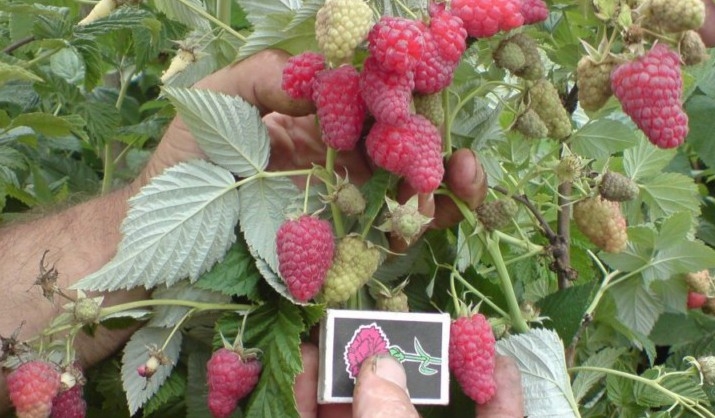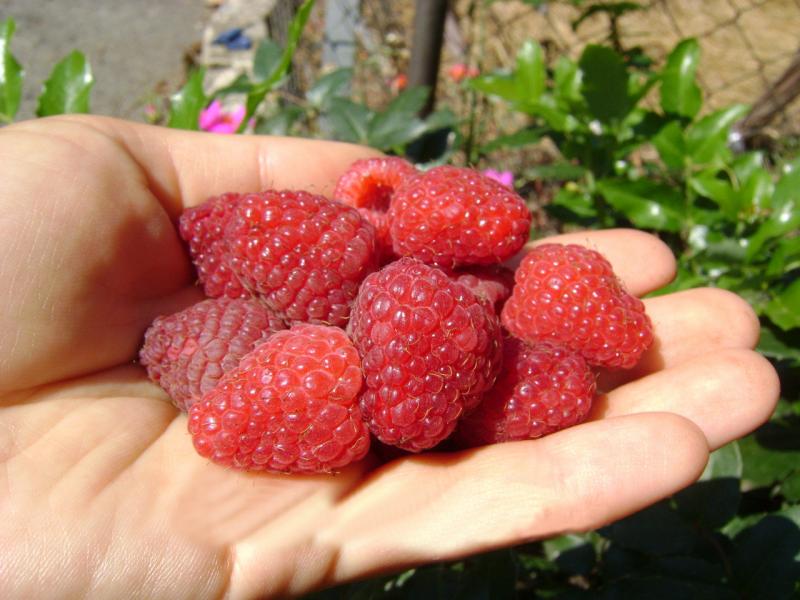Polish lady in a Russian dacha, or how to grow Polan's raspberries
Content
- 1 Breeding history of the variety
- 2 Description of Polana Raspberry
- 3 Characteristics of the variety
- 4 Video "Acquaintance with Polan's raspberries"
- 5 Advantages and disadvantages of the variety
- 6 Planting and caring for Polana's raspberries
- 7 Methods of control and prevention of diseases and pests
- 8 Reviews of summer residents
Breeding history of the variety
The Polana variety appeared in the early 1990s at the Brzezno Institute of Horticulture and Floriculture. Moreover, two wonderful varieties were bred at once - Polana (Polyana) and Polka. The remontant varieties Zeva (Swiss) and Heritage (American) were taken as a basis. The authorship is assigned to Professor Jan Danek, who is a leading expert in the study and selection of raspberries.
To date, more than half of the agricultural land in Poland is allotted for the cultivation of shrubs. The culture very quickly became popular in the post-Soviet space as well. In Russia, the variety has become the most popular in the northwestern regions.

Description of Polana Raspberry
Polana, like all remontant plants, has a unique ability to grow new shoots during one season and bear fruit on them.
Distinctive features of the bush
Polana's bush is rather compact, no more than 1.5 m high. The shoots are upright, elastic, thick and strong. The diameter of the shoot is about 5 cm, so the branches do not bend or break under the weight of the berries. However, according to gardeners, a garter would be useful.
Raspberry shoots branch well, so pinching the top is only necessary to control the height (if necessary).
There are few thorns on the bush, so they do not cause much inconvenience. Leaves of a classic shape with long petioles, large, rich green, arranged alternately. The color is small, white.
Distinctive features of berries
Polana's fruits are worthy of the artist's brush. Correct rounded-conical shape, glossy surface and unique pink-red color. Small drupes are tightly collected in large cones of berries. The average weight of one fruit is 6 g. The berries are juicy, with pleasant sweetness and unobtrusive sourness. The fruits are also characterized by good keeping quality. The ratio of acidity and sweetness directly depends on weather conditions: more sun - more sugar, the prevalence of cloudy weather - victory for sourness.

Characteristics of the variety
In addition to the fact that you can harvest berries from Polana several times per season, the variety has other features.
Drought resistance, frost resistance
The vast majority of raspberry varieties are moisture-loving plants. Polana is no exception, the plant can do without moisture only for a very limited period of time. Prolonged drought will certainly affect the yield and the deterioration of the general condition of the plant.
A big advantage for growing a shrub in Russia is its frost resistance. The bush is able to withstand frost up to 32 ° C. At the same time, the berries ripen even at a low above-zero temperature (up to +5 ° C).
Ripening and fruiting dates
Polana is one of the earliest maturing remontant varieties. The first fruits ripen in July in the southern regions, a little later in other regions, and lasts until October-November. During this period, 80% of the total crop ripens. The berries begin to ripen from the top of the shoot to the middle. After harvesting the first crop, they can be cut (for the development of new shoots of re-fruiting).
The beginning of fruiting of the bush falls on the second year after planting. At the same time, repeated fruiting on two-year-old shoots begins at an earlier period. The fruits ripen every few days, but you can not rush to harvest - the berries can stay on the stalks for more than 5 days.
Productivity from one bush
On average, you can collect up to 5 kg of berries from one bush. With good care and optimal weather conditions, the yield is up to 12 kg / m².
For the season, with properly carried out agrotechnical measures, up to 200 kg can be collected from the raspberry tree in the summer cottage.

Taste and field of application of berries
Berries can be stored for several days in a cool dry room, in the refrigerator for up to a week. For transportation, choose only shallow plastic bowls. In such vessels, the berries will not wrinkle and will not give juice.
Raspberries are suitable for fresh consumption (making mashed potatoes, yoghurts, desserts). They will make delicious confiture, jam, preserves.
You can also make raspberry liqueur or homemade liqueur from Polana fruits.

Video "Acquaintance with Polan's raspberries"
This video presents the main characteristics of the variety.
Advantages and disadvantages of the variety
In addition to unconditional advantages, Polana also has some disadvantages that can be decisive when choosing a variety.
- early ripening, long fruiting period and high yield;
- frost resistance;
- excellent commercial and taste characteristics of fruits: wonderful appearance, density of the structure of berries, small bones, balanced sweet and sour taste;
- high degree of transportability and storage capacity;
- disease resistance;
- easy reproduction;
- fruits do not fall off the shoots for a week.
- intolerance to prolonged drought;
- a large amount of root growth;
- obligatory garter;
- tendency to verticillary wilting.
Planting and caring for Polana's raspberries
There are no difficulties in agronomic procedures for the variety. It is only important to strictly follow the recommendations of experienced gardeners.
Recommended timing
Repaired varieties are recommended to be planted in the fall. The optimal time is late September or early October. Planting at this time allows the shrub to adapt before the onset of the first cold weather. You can plant raspberries in the spring, but this must be done before the start of sap flow.
Choosing a place, soil and seedlings
The best place for Polana would be a sunny, draft-free area. But in the southern regions it is better to choose partially shaded areas with diffused lighting. Any fertile soil with neutral acidity and moderate moisture will do.
It is important to choose a good seedling. The main thing is a healthy root system: flexible, elastic roots, without dry and damaged areas. The height of the shoots is at least 25 cm, with several buds and without damaged areas of the bark.
Landing in trenches
On an industrial scale, raspberries are planted in shallow and narrow trenches (up to half a meter in both indicators). Distance - depending on the root system, but not less than 0.8 m.A ⅓ trench is filled with fertilizers, a seedling is placed, the roots are straightened and sprinkled with soil. The root collar should be 5 cm above the ground level. Each seedling should consist of no more than 4 shoots. At the end, each bush is watered abundantly.

Landing in holes
Landing in holes is carried out according to the scheme of trench landing. There is only one difference - a separate hole is dug for each bush. Often, the near-trunk zone is mulched.
Follow-up care
Polana needs regular hydration. The soil should be soaked 40 cm deep. Watered even before wintering, if a small amount of precipitation fell in the fall. The frequency and amount of watering is determined by the characteristics of the region. In order for moisture to penetrate to the roots and remain in the soil, the near-trunk zone is loosened and mulched with peat.
Pruning and tying a bush
Timely pruning stimulates the formation of new young shoots and an increase in yield on old ones (re-fruiting). Also, don't forget about sanitary spring pruning.
Even the strongest shoots need a garter. A strong gusty wind, especially during the fruiting period, can not only tilt the shoots to the ground, but also simply break them. And harvesting on a tied up bush is much easier.
- Drip irrigation and mulching
- Garter shrubs
- Pruning shoots
Methods of control and prevention of diseases and pests
Polana has good immunity to diseases. But a violation in the implementation of agrotechnical measures can provoke the development of gray rot, anthracnose, verticillium wilt, chlorosis, septoria. Diseases can be prevented by treating the bushes with fungicides.
Raspberries are also threatened by pests - raspberry beetle, aphids, spider mites. You can fight parasites with the help of drugs "Karbofos", "Decis", "Confidor".

Reviews of summer residents
“I am very pleased with the acquisition of Polana. Even in such climatic conditions, a bountiful harvest of delicious berries can be harvested. And the main thing is that the bushes do not freeze. "
“You will not surprise us with delicious berries. But oddly enough, the appearance of raspberries when sold fully compensates for their quite ordinary taste. "
If you have long dreamed of an unpretentious raspberry, be sure to try the Polana variety. Routine grooming activities, choosing a good planting material, and you can enjoy the great taste of the berry.



